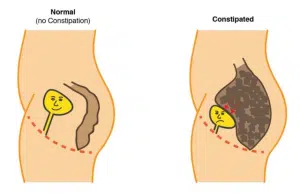Constipation or Faecal Incontinence
Functional constipation in children or adolescents is more common than you think, affecting 25% of children at some point. If your child experiences ongoing stomach pain and difficulty going to the toilet, there’s a high likelihood they’re suffering from this condition. The good news is that treatment options are available for kids’ constipation following a diagnosis.
What are the main symptoms of constipation?
- Hard bowel movements
- Smaller and less frequent bowel movements
- Straining on the toilet
- Pain when going to the toilet
- Abdominal pain
- Bloating
- Frequent poo accidents
- More frequent urination
- Regular urinary tract infections
- Frequent wee accidents
- Regression in toileting abilities
- Delayed toilet training
What can cause constipation in children?
There are various things that may trigger constipation and infrequent bowel movements in young children, including:
- Toilet training
- Changes in routine (for example, an illness or going on holiday)
- Stress events (for example: parents divorcing or starting school)
- A lack of dietary fibre
- Poor fluid intake
- Medication side effects
- Ongoing bowel disorders that should be investigated further
Some children will either consciously or subconsciously trigger constipation by holding in their bowel movements. This can happen when they don’t have easy access to toilets or they had a painful poo in the past that makes them avoid going in the future. It’s also common for children to hold in their bowel movements when playing or doing something as they’re busy.
How can my child be diagnosed with constipation?
Constipation in children can be diagnosed by monitoring bowel habits and checking the symptoms listed earlier. At Sydney Pelvic Clinic, your physiotherapist will ask you to complete a bowel and bladder diary. This lets us see their habits to confirm certain toilet patterns that can be linked to constipation. We will also feel your child’s abdomen to see if their bowel is full. Ultrasounds can sometimes be used as part of the diagnosis as well.
How is kids’ constipation treated?
Functional constipation can be treated by a combination of in-clinic and at-home solutions:
Treating constipation in the clinic
We will use the following techniques to help your child with constipation. Effectively, our treatments revolve around encouraging normal bowel movements.
- Educating your child on the proper pushing technique
- Providing exercises to increase core strength for better pushing
- Educate you (the parent) and your child on what foods are good for better bowel movements
- Prescription of laxatives to help move any impacted stools
- Abdominal massages to help stools travel through the bowel
- Breathing exercises to relax the muscles when going to the toilet
Treating constipation at home
You will be sent home with some tips to help treat your child’s constipation while they’re at home:
- Increase fluid consumption to 8-9 small glasses of fluid a day
- Encourage going to the toilet as soon as your child needs to go
- Sit your child on the toilet 30 minutes after each meal to encourage a routine
- Use a small footstool to elevate your child’s knees above their hips for the proper pooping position
- Encourage your child to relax while on the toilet and take as long as they need – don’t make them rush their bowel movements or they won’t complete them!
- Don’t punish your child for any faecal incontinence – it’s not their fault, use positive reinforcement instead
- Adopt a well-balanced diet with plenty of fibre
- Check with a dietician to see if your child has any food intolerances
- Inform schools/childcare providers so they can support your child when you’re not there.
If you believe your child suffers from constipation, feel free to get in touch with us today. Our Kid’s Continence Team is here to help diagnose any problems and provide the necessary treatment. With our help, we’ll gradually ease any pain and assist your child in developing a more frequent pattern of healthy bowel movements.
Related article: When Toilet Time is Painful

